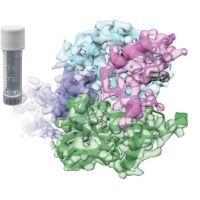Specification
| Organism | Homo sapiens (Human) |
| Expression Host | E.coli |
| Tag Info | N-terminal 6xHis-SUMO-tagged |
| Purity | Greater than 85% by SDS-PAGE |
| Uniprot ID | O75509 |
| Gene Names | TNFRSF21 |
| Alternative Names | Death receptor 6; CD358 |
| Expression Region | Cytoplasmic Domain(371-655aa ) |
| Molecular Weight | 48 kDa |
| Protein Sequence | RKSSRTLKKGPRQDPSAIVEKAGLKKSMTPTQNREKWIYYCNGHGIDILKLVAAQVGSQWKDIYQFLCNASEREVAAFSNGYTADHERAYAALQHWTIRGPEASLAQLISALRQHRRNDVVEKIRGLMEDTTQLETDKLALPMSPSPLSPSPIPSPNAKLENSALLTVEPSPQDKNKGFFVDESEPLLRCDSTSSGSSALSRNGSFITKEKKDTVLRQVRLDPCDLQPIFDDMLHFLNPEELRVIEEIPQAEDKLDRLFEIIGVKSQEASQTLLDSVYSHLPDLL |
| Form | Liquid or Lyophilization |
| Buffer | The default storage buffer is Tris/PBS-based buffer, 5%-50% glycerol if the delivery form is liquid. The lyophilization buffer is Tris/PBS-based buffer, 6% Trehalose, pH 8.0 if the delivery form is lyophilized powder. Please contact us if you have any special requirment. |
| Reconstitution | Please reconstitute protein in deionized sterile water and we recommend that briefly centrifuge thevial prior to opening the vial .We recommend aliquot for long-term storage at -20℃/-80℃. |
Background
| Relevance | Promotes apoptosis, possibly via a pathway that involves the activation of NF-kappa-B. Can also promote apoptosis mediated by BAX and by the release of cytochrome c from the mitochondria into the cytoplasm. Plays a role in neuronal apoptosis, including apoptosis in response to amyloid peptides derived from APP, and is required for both normal cell body death and axonal pruning. Trophic-factor deprivation triggers the cleavage of surface APP by beta-secretase to release sAPP-beta which is further cleaved to release an N-terminal fragment of APP (N-APP). N-APP binds TNFRSF21; this triggers caspase activation and degeneration of both neuronal cell bodies (via caspase-3) and axons (via caspase-6). Negatively regulates oligodendrocyte survival, maturation and myelination. Plays a role in signaling cascades triggered by stimulation of T-cell receptors, in the adaptive immune response and in the regulation of T-cell differentiation and proliferation. Negatively regulates T-cell responses and the release of cytokines such as IL4, IL5, IL10, IL13 and IFNG by Th2 cells. Negatively regulates the production of IgG, IgM and IgM in response to antigens. May inhibit the activation of JNK in response to T-cell stimulation. |
| Involvement in Disease | |
| Subcellular Location | Cell membrane, Single-pass type I membrane protein |
| Protein Families | |
| Tissue Specificity | TNFRSF21 |
QC Data
| Note | Please contact us for QC Data |
| Product Image (Reference Only) |  |

